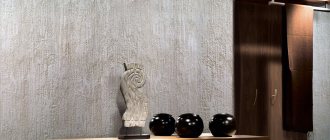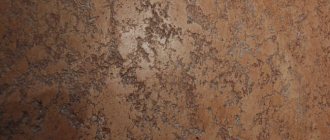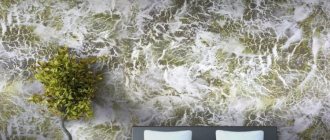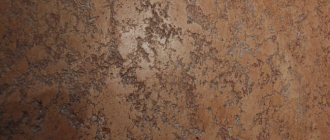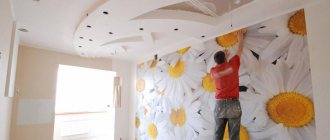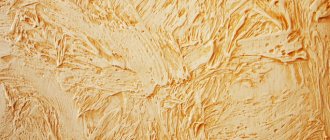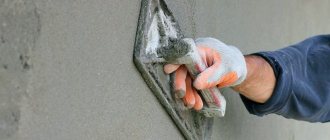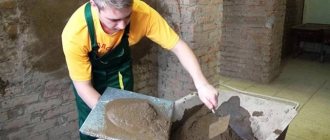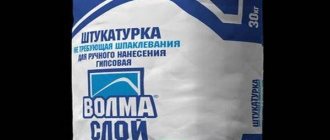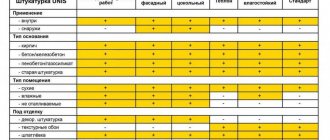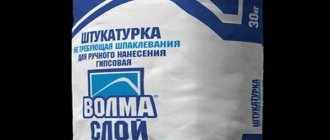Caparol is a trademark that unites enterprises with a century-old history. The company supplies a wide range of building materials throughout Europe. Today it is one of the world's manufacturers of paint and varnish products in Germany, with an annual turnover of 1 billion euros. Decorative plaster, which is produced by companies under the Caparol brand, is presented in a very large assortment and is one of the most popular materials for covering walls.
Features and scope of application of Caparol plasters
Decorative plaster of the German brand Kaparol is a finishing material intended for interior and exterior use. It is characterized by easy application, increased strength, environmental safety and durability. It is based on the smallest mineral particles with a diameter of each crumb of no more than 2 mm.
Caparol contains the following components:
- synthetic resin (in the form of dispersion);
- mineral filler;
- pigment;
- water;
- additives.
The acrylic base allows the finish to be applied to any surface. At the same time, they turn out smooth and even, which provides an almost perfect appearance. The walls become bright and impressive. They look much more original compared to traditional decoration. This is achieved thanks to the grain structure and matte surface.
Conclusion
Decorative plaster from the Kaparol company is an excellent solution for cladding walls and facades. The assortment includes samples to suit every taste. Resistant, durable, high-quality coating will decorate any walls, even very old ones. Modern textures and advanced technologies will ensure easy maintenance and long service life of wall surfaces. And most importantly, the plaster, marked with the Caparol trademark (pattern with a striped elephant), is absolutely harmless to health.
We also offer decorative plasters VGT and Ceresit for viewing.
Types of Caparol plasters for facade and interior work
The German manufacturer produces different types of plasters - silicone, Venetian and others. The most popular ones are described below.
Venetian plaster Caparol
This decorative material is rightly considered the most spectacular compared to other decorative coatings. Its main advantages:
- ecologically pure;
- does not give off odor;
- looks luxurious;
- can be used in rooms with high humidity.
It is better to apply Caparol to specialists with experience, since the final result depends on it
Silicone plaster Kaparol
It is a paste-like mixture to which several components are added. The color is pure white or colored. Characterized by excellent adhesion and vapor permeability. A distinctive feature is that with the help of this coating you can create a relief textured surface. Used for finishing insulated facades and other surfaces.
Silicone mixture is used to create a relief coating
Silicate
Made from potassium glass. Such a coating is most often used during the renovation of ancient buildings, objects related to architectural monuments, and also for the restoration of churches.
The finish goes well with old building materials
But silicate plaster also has a drawback - not every color is suitable for tinting. At the same time, the manufacturer has created a special series of Caparol Amphisilan/Sylitol, which contains a special palette for finishing historical buildings.
Acrylic
Creates structural surfaces, while being somewhat less elastic and vapor permeable compared to other samples. Presented in two designs - “fur coat” and “bark beetle”. They differ in grain size.
Tinting is carried out in accordance with the Kaparol catalog line
The main advantages are a large selection of colors and an affordable price. The coating is not too expensive, but at the same time it is practical and durable. Surface tones are rich and bright. This is explained by the fact that acrylic perfectly holds the coloring pigment, so the facades are very attractive.
Mineral
Mineral - a common type of plaster
It is produced on the basis of cement, lime, and marble chips. Release form – dry mixture of fine fraction (powder with grains 0.5-5 mm). Depending on the size of the crumbs, you can create a more or less pronounced surface relief.
Mainly used for exterior decoration. It is important to take into account that large relief looks better from a distance. If you plan to finish the inner surface, it is preferable to use a material with small granules. Then they will look neat and quite attractive.
Nuances and rules for using Caparol plasters
To correctly apply Caparol decorative plaster, as in the photo, you must follow these practical recommendations:
- Apply with a stainless steel trowel.
- When applying decorative plaster mechanically, use a unit with a mixer and pump.
- Homogeneous walls should be processed in one pass.
- If the wall is of a mixed type, they go through two layers, putting “wet on wet”.
- If you need to strengthen the layer on a wooden covering, ceiling strips, next to blinds or frames, additional reinforcement is used.
- Each decorative layer must have a thickness of at least 12 mm. If the thickness is more than 20 mm, work in layers as the previous one dries.
- The surfaces must be allowed to dry completely, which can take up to two days, provided there is ventilation.
- It is important to ensure a constant flow of air, but without drafts.
The material allows you to get a textured, original surface
Manufacturer: Deutsche Amphibolin-Werke von Robert Murjahn Stiftung & Co KG
The main office and production plant of Caparol (Deutsche Amphibolin-Werke von Robert Murjahn Stiftung & Co KG) are located in Germany in the state of Hesse. But almost half of the turnover comes from other countries.
In Europe, and then in Asia, subsidiaries were formed on the basis of equity participation with local partners. Abroad, Caparol has its own production sites or representative offices in more than 30 countries. Here are just a few of them:
- “Krūza” (Latvia);
- “amurs.lv” (Latvia);
- Caparol Lietuva, UAB (Lithuania);
- "Discom" (Belarus);
- "Caparol Ukraine";
- "Caparol Stupino" (Russia);
- LLC "Caparol" (St. Petersburg)
Review of popular Caparol plasters
Kaparol produces several types of decorative plasters. An overview of the most popular materials is presented below.
Decorative facade plaster Caparol Mineral-Leichtputz 134
Finishing material for outdoor use. Dry plaster is packed in bags weighing 25 kg.
Color Caparol 134 – white
Decorative facade plaster Caparol Mineral-Leichtputz 139
Caparol Mineral-Leichtputz 139 – plaster for application to concrete external and internal surfaces
The crumb is 2 mm in diameter, not glossy, matte. It is applied to the mineral surface of different parts of the building (fence, base, facade, and others). Consumed in quantities of 2.1 kg per square meter.
Decorative plaster Caparol K20
Caparol K20 – white finish, intended for:
- concrete;
- matte surface with dispersion paint;
- mineral coating.
Not for use on plastic and wooden surfaces. Main characteristics of the material:
- ecologically pure;
- does not ignite;
- alkali resistant;
- diluted with water;
- easy to apply;
- has water-repellent properties;
- resistant to precipitation.
Decorative plaster Kaparol is matte, does not shine in the sun
Apply the composition to a flat, dry, cleaned surface free of biological contaminants (mold, algae, moss and others).
Plaster Kaparol 170
Mineral lightweight finishing material of primer type
This is a decorative plaster that is specially designed for low-density heat-insulating structures. Ideally suited for the following materials:
- expanded clay;
- porous concrete;
- light brick;
- pumice and others.
The main advantages include the following:
- easy application;
- can be applied manually and mechanically;
- good thermal insulation qualities;
- environmentally friendly material;
- high vapor permeability;
- Contains additives that improve grip.
Important! The optimal temperature for applying this decorative plaster Caparol is about 20-25 degrees. The minimum permissible temperature is 5 degrees Celsius.
Plaster Caparol AmphiSilan Fassadenputz FEIN
This is fine decorative plaster Caparol with a grain diameter of 1 mm. Key Features and Benefits:
- color white;
- pasty consistency;
- difficult to ignite;
- easy to use;
- it is possible to add paint, but not more than 2%;
- There is no gloss, the surface is matte.
The material is used as a smooth stucco and facade covering in different directions:
- thermal insulation;
- concrete, old mineral compounds;
- plaster layer;
- matte surfaces with dispersion or silicate paint.
Not suitable for wooden, plastic and various internal surfaces
Plaster Caparol Interior
It is a cement-lime plaster for carrying out interior work manually or mechanically.
The material is used for leveling or priming finishing
Also, decorative plaster Kaparol can be used for walls made of silicate and ceramic bricks, foam concrete blocks. It can be used over a layer of cement-lime or lime plaster.
Main properties and advantages:
- excellent transmission capacity;
- very low tension;
- high mechanical strength;
- the material is environmentally friendly.
Capatect-Fassadenputz R 20
This decorative plaster Kaparol is called “Bark Beetle”. Structural material intended for interior work in premises, including stairs, landings and hallways. Can be applied to a variety of surfaces, including:
- drywall;
- concrete;
- asbestos cement;
- plaster;
- masonry;
- plywood;
- Fiberboard;
- Chipboard.
The average consumption rate is from 2.0 to 2.8 kg per square meter. The color is white, the surface is matte. It has good elasticity, moisture resistance and steam permeability. Fractions measuring 2 mm are packaged in 25 kg buckets.
Thanks to its durability, the coating lasts for many years without any complaints.
Caparol Capatect Fassadenputz K
Pebble plaster Kaparol is a white finishing material for exterior work. Designed for fences, facades, plinths and other buildings. Used for mineral surfaces - brick, concrete, plaster.
Main advantages of the material;
- resistant to alkali and precipitation;
- has water-repellent properties;
- difficult to ignite;
- ecologically pure;
- the smell is weak;
- dilutes well with water;
- high diffusion of water vapor;
- simple and convenient to apply.
Does not have shine, the surface is matte. You can add a maximum of 2% paint, since with further saturation the consistency will become too liquid. The consumption rate is about 2.7 kg per 1 square meter.
Customer Reviews
Daniil, 31 years old, St. Petersburg
“For finishing in my new office I used decorative plaster Stucco Decor DI PERLA with a metallic sheen. I was told that this is a new product. I am a modern entrepreneur, I love different innovations, so I decided to try something new. It turned out very impressive. The craftsmen did everything subtly and flawlessly. I’m very pleased with the result.”
Ivan, 44 years old, Stupino
“I’ve been working as a finisher for a long time. I specialize in plaster coatings. Recently, they have increasingly begun to order interior decoration with Caparol products. I recently used Caparol Capadecor-Putz ready-mix. It's a pleasure to work with her! It is easy to apply with a regular roller and creates a beautiful structural coating. I recommend to all".
Maria, 36 years old, Kupavna
“My family and I decided to update the facade of our house. We thought for a long time what to choose, but did not skimp on material. We chose Caparol AmphiSilan Fassadenputz silicone plaster with a “bark beetle” texture. It turned out great! The house looks stunning! We also painted it with paint from the same company. It looks, let me tell you, simply gorgeous. Now our house is the best in the area!”
Small balcony design
Selecting tulle for the living room is described here.
How to properly plan a black and white room design https://trendsdesign.ru/home/liv/chyorno-belyj-dizajn-pravila-rekomendacii-varianty-oformleniya.html
Advantages and disadvantages
The decorative material Caparol has several important advantages.
Pros:
- high decorative properties;
- strength;
- ease of application;
- resistance to impacts and scratches;
- can be applied to any surface;
- does not burn;
- easy to clean;
- you can decorate buildings inside and outside;
- wide choice of colors available;
- withstands restoration of coatings well.
But there are also some disadvantages:
- adheres well, so it is difficult to dismantle;
- is quite expensive;
- requires high-quality cleaning of the surface before starting work.
